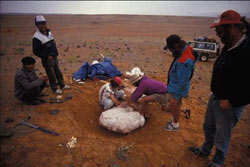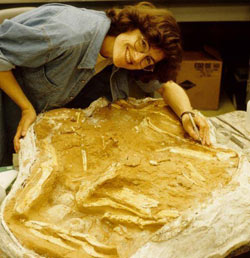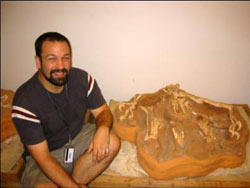Oviraptor
Finding

This fossil specimen was found in an area of Mongolia named Ukhaa Tolgod. Within days it was realized how rich this spot was in fossils. Mark Norell, one of the expedition leaders, found claws weathering out of the ground. Preparator Amy Davidson and a colleague, Luis Chiappe, were asked to excavate further and determine whether the specimen was complete enough to warrant collection. The sand was so soft that with hands, brushes, and knives they were quickly able to see the position of the skeleton in the ground minus what had weathered away on top. To their great excitement, they soon realized that the fossil consisted of much more than the exposed claws.

As Amy dug down with a rock hammer she heard a brittle crunch. Looking at the piece she had knocked free she saw egg shell and she and Luis realized that there were eggs - probably a nest underneath this squatting skeleton. It was an exciting moment of discovery. Now they were sure this specimen was worth collecting and set to it with even more enthusiasm. This image depicts the point where they had finished trenching and pedestalling.
 |  |
It is difficult and sometimes even dangerous to attempt to extract fossil bones from their surrounding matrix under field conditions. Instead the excavators extract an entire block that hopefully containing the entire specimen. This is an imperfect art as the team tries to map out the position of the skeleton as best they can. The specimen has survived 75 million years packed in the matrix - it is better to unpack it in the controlled conditions of the lab.

Jackets should be built to be strong but able to come apart in layers and separate from the specimen. Amy used the typical separating layer of wet toilet paper over the top of the specimen. It’s also good to write notes and take photos for reference when un-jacketing. The jacket is ultimately flipped over and the fact that there were no other fragments of bone remaining underneath indicated that they had collected the entire specimen in the block.
After the field collecting was complete the blocks were trucked back to Ulan Bator where the team scavenged materials to build crates that would be strong enough to ensure that the specimens could be shipped safely to the United States.
Revealing
 |  |
One has not actually “collected” the specimen until it has arrived in the lab and the jacket has been safely opened. Sadly, some specimens make it all the way back only to be seriously damaged when “unjacketed”. Jackets should never be opened like the top of a jack-o-lantern because the plaster may be stuck to the bone and rip it up. It is best to open a small window to see where you are and then score and peel away the plaster in layers. It’s more work for the preparator, but much safer for the specimen. For this jacket Amy used a Stryker medical cast cutter, which is actually a medical tool for cutting casts off broken limbs.
 |  | |
 |
With the top of the plaster jacket opened up Amy’s work started up where she left off in the Gobi desert. Soft sand can be scraped away with wooden tools and steel needles, and harder lumps with the sand are removed (“pecked” off) with an "airscribe", a pneumatic (air-driven) needle similar to a mini jackhammer. The microscope is very important for examining fragments and smaller specimens.

After about a month of careful work, the fossil is extensively revealed. While some of the specimen was lost to erosion prior to its discovery, what remained revealed the remarkable discovery of an adult oviraptorid dinosaur with its arms wrapped around the perimeter of a nest that contained more than twenty eggs. This position, just like a brooding chicken, confirmed that some dinosaurs incubated their eggs like modern birds. The fossil was nicknamed “Big Mamma”.
Studying
The painstaking preparation of this specimen revealed not only its beauty, but also important new evidence: a delicate trace of a curve at the end of the bony claw is recognized as the remains of the horny sheath; the size, shape and texture of the eggs could be examined; the position of the skeleton relative to the eggs gave rise to clues about behavior; remains of two centipedes which could have been stomach contents or feeding on the carcass give rise to other theories; and evidence of a healed broken arm on the adult tell a bit about how the oviraptorid lived.

The specimen was first published in the prestigious scientific journal Nature and caused a sensation in both the scientific and popular press. You can read the entire Nature article online as well as access others:
“Dinosaur eggs and nesting behaviors: A paleobiological investigation” by Gerald Grellet-Tinner, Luis Chiappe, Mark Norell, and David Bottjer in the journal Palaeogeography, Palaeoclimatology, Palaeoecology, 2006.
“Growth patterns in brooding dinosaurs reveals the timing of sexual maturity in non-avian dinosaurs and genesis of the avian condition” in Biology Letters, 2007:3 by Gregory M Erickson, Kristina Curry Rogers, David J Varricchio, Mark A Norell and Xing Xu
In addition to the research that was conducted, the specimen was molded so that casts could be made. Some of the casts were placed on exhibit and others were made available for scientists to study and for other educational study purposes.

The specimen was put on display as part of the AMNH’s 2000 exhibit
Fighting Dinosaurs: New Discoveries From Mongolia
. This is the only time to date that the real specimen has been on public view in the USA.

However, one of the casts of the specimen is currently on view in a permanent AMNH exhibit Moments of Discovery that examines this important find.
Click here to watch a video of Amy that is included in the exhibit.

After casting was completed, the specimen was placed on a sturdy wood pallet in one of the Museum’s collection storage rooms. It was brought back to the lab from time to time for further study. In 2005 it was packed into a specially-constructed crate and flown back to Mongolia and its permanent home in Ulan Bator.

